Table of contents
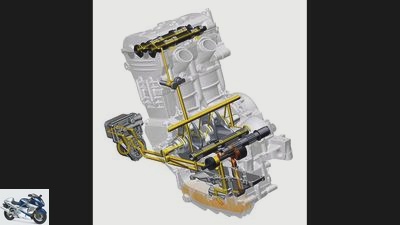
Drawing: archive
counselor
technology & future
Technology guide: lubrication
Technology guide: lubrication
Knowledge: Nothing works without oil
From the first sound to the highest speed, the engine oil has to be there. Only reliable lubrication will keep the engine alive.
Werner Koch
December 18, 2009
What do we care about engine lubrication in modern motorcycles?? In most cases, the workshop will change the oil, including the filter, and the correct type of oil is given in the manual. All you have to do is look into the sight glass from time to time to check the oil level – that’s it. However, if you take a closer look at the task of the oil circuit, it becomes clear how complex and elaborate this system is. The job is far from over with lubrication alone.
Buy complete article
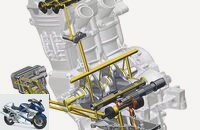
Technology guide: lubrication
Knowledge: Nothing works without oil
4 pages) as PDF
€ 2.00
Buy now
Where there is no water, the oil cools
The hottest areas of the engine are where the combustion takes place: in the cylinder head and on the piston crown. Even if the cooling water surrounds the extremely hot area in the exhaust duct, the engine oil absorbs a large part of the heat and transports it to the fresh air via the heat exchanger or a special lamellar oil cooler. This is the only way for the designers to prevent heat collapse. Up until the early 1990s, the engines of the Suzuki GSX-R super sports car demonstrated how efficiently heat dissipation through the lubricating oil works. Under the name SACS (Suzuki Advanced Cooling System), the sports and racing engines were kept thermally in the green area by means of an ingenious oil flow through the engine and a large oil cooler (see above right).
The piston racing up and down is nowadays cooled and lubricated in almost all engines by a nozzle in the crankcase and the targeted oil jet from below onto the piston crown. It is intentional that the upper piston pin bearing is also hit by the spray oil; because this is the only plain bearing in the engine that is not supplied with oil pressure. The reason: the piston pin does not rotate, but only moves back and forth with a very small angle of rotation. In addition to the insufficient supply of lubricating oil, there is often the poorly chosen friction pairing steel on steel, which is the reason that piston pins and connecting rod eyes cause problems on many MOTORRAD endurance test machines.
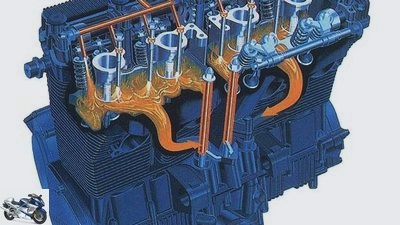
Drawing: archive
Suzuki air / oil cooling: The oil cooling introduced in the legendary Suzuki GSX-R 750 from 1985 works with two oil circuits. One pump supplies the bearing points with oil pressure, a second pump conveys the oil via a large oil cooler into the cylinder head, where it flows around the thermally highly stressed combustion chambers and the outlet area (yellow oil flow). Dainty cooling fins on the cylinder and head ensure additional heat dissipation.
Oil seals where there is no seal
Every shaft seal (“Simmerring”) and every labyrinth seal is supported in its function by the oil. In addition, the oil ensures a reduction in the friction between the shaft and the Simmerring, as the fine plastic sealing lips would be ruined in no time, especially at high speeds without oil. The oil cushion, which is deposited between all moving parts, also cushions and cushions the hard metallic movements of many components and thus ensures that the engine runs more quietly and with less vibration.
Oil cleans and cares for the engine down to the last corner
Gaseous, liquid and aggressive substances that pass through the piston rings, known as “Blow-by”, get into the crankcase and cannot be filtered, are absorbed by high-quality oils, neutralized and disposed of during regular oil changes. In addition to cleaning, oil also has the task of protecting all components, regardless of whether they are made of aluminum or steel, from corrosion.
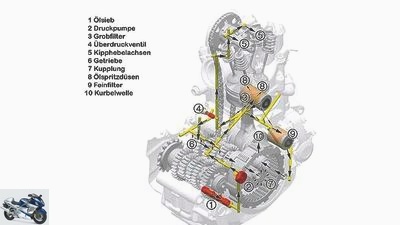
Drawing: archive
Pressure circulation lubrication: In order to ensure the lubrication of the four-stroke engine, the oil is pressed from the pump (2) via an oil filter (9) to the slide bearings of the crank drive. Components such as gear wheels, oil bath clutches, valve trains and pistons are lubricated by spray oil or only by the oil mist. The filters hold back fine abrasion and metallic particles, for example small surface chippings on the gear wheels (pitting). These would destroy the plain bearings by scoring.
Oil lubricates best under pressure
If the bearing clearance of the plain bearings is correct (0.03 to 0.05 mm), an oil pressure of around 3.5 bar ensures a long service life, minimal friction and thus low power losses, i.e. higher engine performance and lower consumption.
If the oil pressure falls below around 1.5 bar, the lubricating film can collapse, the bearings run dry and seize. However, too high an oil pressure can damage the so-called three-substance bearings (see sketch on page 109). Therefore, a pressure relief valve on the oil pump regulates the oil pressure down to the optimum pressure for the respective engine type. The excess capacity of the oil pressure is necessary in order to guarantee fast, reliable lubrication right down to the most distant bearing in the case of cold, viscous oil and low idle gas.
The smallest disturbances can collapse the lubrication system
But even if the oil level is too high, there is a risk because the lubricating oil protrudes into the crankshaft drive so that the oscillating connecting rods and the rotation of the crank webs and the clutch basket make it frothy. If the proportion of air bubbles trapped in the oil exceeds a certain percentage, a reliable lubricating film no longer builds up, the bearings are so poorly lubricated in continuous operation that the two friction partners in the area of the highest pressure load, i.e. around 70 degrees after the ignition process, come into metallic contact come and the bearing metal is removed.
Lubrication faults due to a clogged wire filter due to oil sludge in front of the pump are extremely rare on motorcycles, especially since the oil change intervals are many times shorter than with car engines.
In the event of a loss of oil pressure, regardless of the cause, the red oil pressure lamp in the cockpit lights up as a visual warning signal. At this point, the friction of the plain bearings increases enormously, the surface made of the white metal alloy heats up and begins to smear, the engine damage can no longer be stopped. At rated speed and high load, just a few seconds without oil pressure are enough to permanently destroy the bearings. Even if the oil pressure stabilizes again afterwards, the bearing is so damaged that the collapse is only a matter of time.
If one increasingly hears knocking engine noises, one can often make out the fine chips or brass-containing particles of the attacked bearing when examining the engine oil and thoroughly rubbing out the oil filter chamber. Which precludes further, no matter how gentle, driving under all circumstances. Also because bearing damage in the early stages can usually still be repaired and no other components have been affected. However, if the connecting rod or crankshaft has worked its way up to a complete mechanical failure, new parts are needed. And that blows quite a hole in the till.
The various engine lubrication systems and their advantages and disadvantages are dealt with in MOTORRAD issue 03/2010.
The oil pump
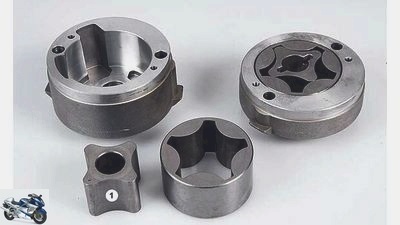
fact
The so-called trochoid gear (1) conveys the oil from the suction line under pressure into the lubrication system.
While Honda still used capricious piston pumps in the 1960s, gear pumps in various versions have become established in almost all four-stroke engines. In most motorcycles, Eaton pumps with trochoidal teeth and an eccentric outer ring ensure a very reliable oil supply even when the engine is cold and the engine speed is low. The mechanically driven gear sucks the oil out of the oil pan and presses it through the chambers into the oil channels. When the engine speed increases and the oil pressure is high, a pressure relief valve opens and regulates the oil pressure down to around 3.5 bar.
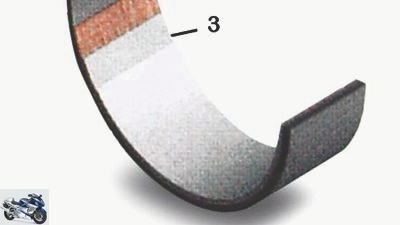
fact
Structure of a three-substance bearing shell.
The crankshaft and connecting rod are equipped with three-substance bearing shells. On the sturdy steel support shell (1) are a lead bronze alloy (2) and the actual bearings-
surface made of a soft white metal (3) applied.
Bearing damage
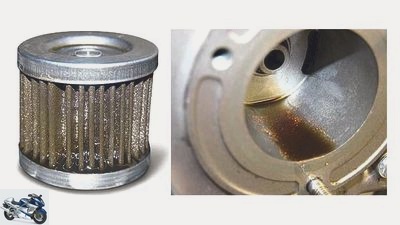
fact
Brass-colored abrasion indicates the complete destruction of a three-substance bearing in the crank drive. The particles can be found in the filter and also in the housing.
Even if the reliability of modern motorcycles is extremely high, bearing damage is still one of the most common reasons for failure. The causes: Insufficient oil pressure, poor fit or too large tolerances. Bearing damage in the crank drive is indicated by knocking or tinkling noises, especially under load. When dismantling the oil filter, metallic deposits allow conclusions to be drawn about the impending damage. In the case of such a diagnosis, the motor must never be used any longer.

fact
Calls in the connecting rod bearing.
Large scoring on the lower connecting rod bearing, where the lead bronze already shimmers through under the low-friction white metal layer.

fact
Abrasion on the journal.
Bearing damage in an advanced stage also damage the ground crank or bearing journals. The lubrication holes are easy to see.
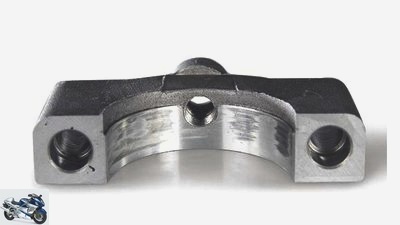
fact
Abrasion on the camshaft.
The camshafts mounted directly in the cast aluminum of the cylinder head are very sensitive and cannot be repaired.
Related articles
-
Guide: Technology – engine lubrication
BILLION counselor workshop Guide: Technology – engine lubrication Guide: Technology – Motors and Drive Everything about engine lubrication To ensure…
-
17th pictures archive 1/17 The BMW F 800 engine, with its oil ducts running through it, shows how complex the pressure circulating lubrication is….
-
Technology: engine technology super sports car
fact 23 pictures fact 1/23 The Honda Fireblade has been a great performer for twenty years. PS takes a close look at the development of engine…
-
Technology development in valve actuation
factstudio.de 23 pictures Katrin Sdun 1/23 Before valve actuation via rocker arms prevailed, numerous other designs determined the state of the art. Ralf…
-
Technology: suspension and chassis
fact accesories landing gear & Spring elements Technology: suspension and chassis Technology: suspension and chassis New trend: Big Piston Fork New trend…
-
Engine cooling technology: Air cooling will soon be obsolete?
Photos: Manufacturer motorcycles Engine cooling technology: air cooling will soon be obsolete? Technology: engine cooling Air cooling will soon be…
-
Technology: BMW S 1000 RR engine in detail
BMW 13th pictures Artist 1/13 The on-board tool kit of the BMW almost ties in with old traditions. With the help of the nine-part set you can strip the…
-
2snap counselor technology & future Technology report Technology report Traction control Content of Traction control ?? Everyday in the car, hardly…
-
Jahn 14th pictures Jahn 1/14 Because Magura do not want to offer the new HC3 brake pump as a pure racing accessory, but also for all road drivers, this…
-
Technology: Seamless transmission from the Honda RC 213 V.
2snap Sports & scene Motorsport Technology: Seamless transmission from the Honda RC 213 V. MOTOGP technology seamless gear of the Honda RC 213 V Full…